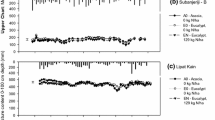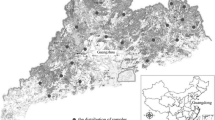Abstract
Spatial patterns of soil water depletion by Eucalyptus spp. were surveyed to assess the potential of tree belts and short rotation phase farming with trees for groundwater recharge reduction and salinity control. Soils were sampled to depths of up to 10 m in transects perpendicular to 4- to 7-year-old mallee eucalypt belts (Eucalyptus horistes, E. kochii ssp. plenissima, E. loxophleba ssp. lissophloia, E. polybractea) and in a 4 year-old block of E. astringens. Results indicate that the eucalypt species can exploit soil water to depths of at least 8–10 m within 7 years of planting. The root systems of these eucalypts were able to penetrate clayey subsoils with bulk densities of up to 2.0 g cm−3. Leaf area indexes of tree belts were 2–10 times greater than those predicted for natural vegetation, probably as a result of exploiting a greater amount of soil water stored under the agricultural system. The lateral influence of mallee belts, as indicated by soil water contents that were depleted to wilting point, ranged from 15–42 m. The resulting dry soil zone provided an effective barrier to groundwater recharge by incident rainfall thereby lessening the risk of salinisation in the agricultural landscape. The width of this barrier to recharge was predicted to range from 7 m to 54 m based on leaf area.
Similar content being viewed by others
References
Allison GB, Cook PG, Barnett SR, Walker GR, Jolly ID, Hughes MW (1990) Land clearance and river salinisation in the western Murray Basin, Australia. J Hydrol 119:1–20
Andrew AH, Noble IR, Lange RT (1979) A non-destructive method for estimating the weight of forage shrubs. Aust Range J 1:777–782
Canadell J, Jackson RB, Ehleringer JR, Mooney HA, Sala OE, Schulze ED (1996) Maximum rooting depth of vegetation types at the global scale. Oecologia 108:583–595
Churchward HM, Gunn RH (1983) Stripping of deep weathered mantles and its significance to soil patterns. In Soils: an Australian Viewpoint. CSIRO. Melbourne/Academic Press, London, pp 73–81
Dye PJ (1996) Response of Eucalyptus grandis to soil water deficits. Tree Physiol 16:233–238
Eastham J, Scott PR, Steckis R (1994) Components of the water balance for tree species under evaluation for agroforestry to control salinity in the wheatbelt of Western Australia. Agroforestry Syst 26:157–169
Ellis TW, Hatton TJ, Nuberg IK (1999) A simple method for estimating recharge from low rainfall agroforestry systems. In Musey A, Santos Pereira L, Fritsch M (eds) Envirowater 99: 2nd Inter-Regional Conference on Environment-Water, Laussane, Switzerland, 1999
Gee GW, Bauder JW (1986) Particle-size analysis. In: Klute A (ed) Methods of soil analysis, Part 1. Physical and mineralogical methods. American Society of Agronomy-Soil Science Society of America, Madison, Wisconsin, pp 383–411
George PR, Wren BA (1985) Crop tolerance to soil salinity. Western Australian Department of Agriculture
George RJ, McFarlane DJ, Nulsen RA (1997) Salinity threatens the viability of agriculture and ecosystems in Western Australia. Hydrogeol J 5:6–21
Greacen EL, Walker GR, Cook PR (1989) Procedure for filter paper method of measuring soil water suction. In CSIRO Div. Soils Div. Rep. CSIRO Australia Division of Soils, 7 pp
Harper RJ, Hatton TJ, Crombie DS, Dawes WR, Abbott LK, Challen RP, House C (2000) Phase farming with trees: a scoping study of its potential for salinity control, soil quality enhancement and farm income improvement in dryland areas of southern Australia. Rural Industries Research and Development Corporation, Canberra, 53 pp
Keighery G, Halse S, McKenzie N (2001) Why wheatbelt valleys are valuable and vulnerable: the ecology of wheatbelt valleys and threats to their survival. In Dealing with Salinity in Wheatbelt Valleys, Merredin, Western Australia, 2001, pp 55–65
Knight A, Blott K, Portelli M, Hignett C (2002) Use of tree and shrub belts to control leakage in three dryland cropping environments. Aust J Agric Res 53:571–586
McArthur WM (1991) Reference soils of south-western Australia. Australian Society of Soil Science Inc. (WA Branch), Perth, 265 pp
McMahon JP, Hutchinson MF, Nix HA, Ord KD (1996) ANUCLIM Version 1 User’s Guide. Centre for Resource and Environmental Studies, Australian National University
Moore G (1998) SOILGUIDE: A handbook for understanding and managing agricultural soils. Agriculture WA, Perth
Nambiar EKS, Sands R (1992) Effects of compaction and simulated root channels in the subsoil on root development, water uptake and growth of radiata pine. Tree Physiol 10:297–306
National Land and Water Resources Audit (2001) Dryland Salinity in Australia. A summary of the National Land and Water Resources Audit’s Australian Dryland Salinity Assessment 2000. National Land and Water Resources Audit, Canberra
Nulsen RA, Bligh KJ, Baxter IN, Solin EJ, Imrie DH (1986) The fate of rainfall in a mallee and heath vegetated catchment in southern Western Australia. Agric Water Manage 4:173–186
Rayment GE, Higginson FR (1992) Australian laboratory handbook of soil and water chemical methods. Inkata Press, Melbourne, 330 pp
Reeve MJ and Carter AD (1991) Water release characteristic. In: Smith KA, Mullins CE (eds) Soil analysis physical methods. pp 111–160
Scholander PF, Hammel HT, Bradstreet ED, Hemmingsen EA (1965) Sap pressure in vascular plants, negative hydrostatic pressure can be measured in plants. Science 148:339–346
Stirzaker RJ, Cook FJ, Knight JH (1999) Where to plant trees on cropping land for control of dryland salinity: some approximate solutions. Agric Water Manage 39:115–133
Stirzaker RJ, Ellis TW, Lefroy EC (2002) Mixing tree belts with agriculture. In: Stirzaker R, Vertessy R, Sarre A (eds) Trees, water and salt – an Australian guide to using trees for healthy catchments and productive farms. Rural Industries Research and Development Corporation, Canberra, pp 77–92
Stone EL, Kalisz PJ (1991) On the maximum extent of tree roots. For Ecol Manage 46:59–102
Scientific Software Group (2003) Surfer 7.0. Scientific Software Group, Sandy, Utah
Taras MJ, Greenberg AE, Hoak RD, Rand MC (1975) Standard methods for the examination of water and wastewater. American Public Heath Association, Washington, DC, pp 613–614
Tennant D, Hall D (2001) Improving water use of annual crops and pastures-limitations and opportunities in Western Australia. Aust J Agric Res 52:171–182
Thorburn PJ, Hatton TJ, Walker GR (1993) Combining measurements of transpiration and stable isotopes of water to determine groundwater discharge from forests. J Hydrol 150:563–587
Ward PR and Asseng S (2002) The viability of a phase rotation in salinity control. In Fenner Conference on the Environment 2002, Canberra, ACT, 2002, pp 150–158
Ward PR, Dunin FX, Micin SF (2002) Water use and root growth by annual and perennial pastures and subsequent crops in a phase rotation. Agric Water Manage 53:83–97
Acknowledgements
This work was funded by the Australian Government’s Farm Forestry Program Project 983197 “Putting Trees in Their Place. We wish to thank the Bailey, Bird, Gould, Stanley and Young families, the Great Southern Piggery and the Department of Agriculture for allowing sampling to be carried out on their properties, and Andrew Stilwell, Robert Archibald, Shelley McArthur and Yvette Oliver for assistance in the field and laboratory.
Author information
Authors and Affiliations
Corresponding author
Rights and permissions
About this article
Cite this article
Robinson, N., Harper, R.J. & Smettem, K.R.J. Soil water depletion by Eucalyptus spp. integrated into dryland agricultural systems. Plant Soil 286, 141–151 (2006). https://doi.org/10.1007/s11104-006-9032-4
Received:
Accepted:
Published:
Issue Date:
DOI: https://doi.org/10.1007/s11104-006-9032-4




